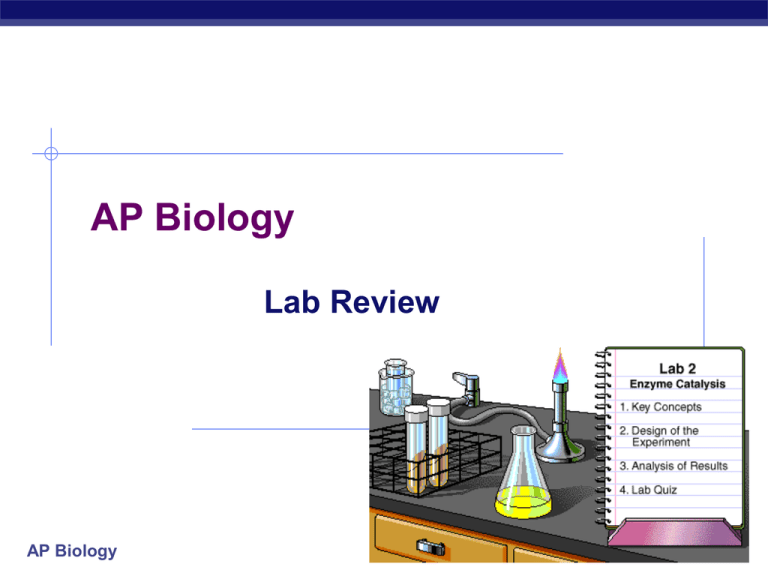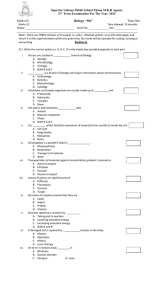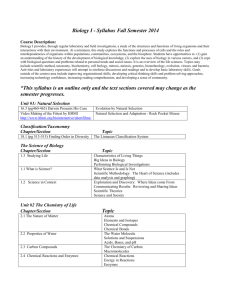AP & Regents Biology
advertisement

AP Biology Lab Review AP Biology Lab 1: Diffusion & Osmosis AP Biology Lab 1: Diffusion & Osmosis Description dialysis tubing filled with starchglucose solution in beaker filled with KI solution potato cores in sucrose solutions determining solute concentration of different solutions AP Biology Lab 1: Diffusion & Osmosis Concepts semi-permeable membrane diffusion osmosis solutions hypotonic hypertonic isotonic AP Biology water potential Lab 1: Diffusion & Osmosis Conclusions water moves from high concentration of water (hypotonic=low solute) to low concentration of water (hypertonic=high solute) solute concentration & size of molecule affect movement through semi-permeable membrane AP Biology Lab 1: Diffusion & Osmosis ESSAY 1992 A laboratory assistant prepared solutions of 0.8 M, 0.6 M, 0.4 M, and 0.2 M sucrose, but forgot to label them. After realizing the error, the assistant randomly labeled the flasks containing these four unknown solutions as flask A, flask B, flask C, and flask D. Design an experiment, based on the principles of diffusion and osmosis, that the assistant could use to determine which of the flasks contains each of the four unknown solutions. Include in your answer: a. a description of how you would set up and perform the experiment; b. the results you would expect from your experiment; and c. an explanation of those results based on the principles involved. Be sure to clearly state the principles addressed in your discussion. AP Biology Lab 2: Enzyme Catalysis AP Biology Lab 2: Enzyme Catalysis Description measured factors affecting enzyme activity H2O2 H2O + O2 catalase measured rate of O2 production AP Biology Lab 2: Enzyme Catalysis Concepts substrate enzyme enzyme structure product denaturation of protein experimental design rate of reactivity reaction with enzyme vs. reaction without enzyme optimum pH or temperature test at various pH or temperature values AP Biology Lab 2: Enzyme Catalysis Conclusions enzyme reaction rate is affected by: pH temperature substrate concentration enzyme concentration calculate rate? AP Biology Lab 2: Enzyme Catalysis ESSAY 2000 The effects of pH and temperature were studied for an enzyme-catalyzed reaction. The following results were obtained. a. How do (1) temperature and (2) pH affect the activity of this enzyme? In your answer, include a discussion of the relationship between the structure and the function of this enzyme, as well as a discussion of how structure and function of enzymes are affected by temperature and pH. b. Describe a controlled experiment that could have produced the data shown for either temperature or pH. Be sure to state the hypothesis that was tested here. AP Biology Lab 3: Mitosis & Meiosis AP Biology Lab 3: Mitosis & Meiosis Description cell stages of mitosis exam slide of onion root tip count number of cells in each stage to determine relative time spent in each stage stages of & crossing over in meiosis model cell stages & crossing over farther genes are from each other the greater number of crossovers AP Biology Lab 3: Mitosis & Meiosis Concepts mitosis interphase prophase metaphase anaphase telophase I meiosis meiosis 1 separate homologous pairs meiosis 2 separate sister chromatids crossing over in prophase 1 AP Biology P M A T Lab 3: Mitosis & Meiosis Description cell stages of mitosis exam slide of onion root tip count number of cells in each stage to determine relative time spent in each stage crossing over in meiosis farther gene is from centromere the greater number of crossovers observed crossing over in fungus, Sordaria arrangement of ascospores AP Biology Sordaria analysis total crossover % crossover = total offspring distance from = centromere AP Biology % crossover 2 Lab 3: Mitosis & Meiosis Conclusions Mitosis cell division growth, repair making clones longest phase = interphase each subsequent phase is shorter in duration Meiosis reduction division making gametes increasing variation crossing over in Prophase 1 AP Biology Lab 3: Mitosis & Meiosis ESSAY 1987 Discuss the process of cell division in animals. Include a description of mitosis and cytokinesis, and of the other phases of the cell cycle. Do not include meiosis. ESSAY 2004 Meiosis reduces chromosome number and rearranges genetic information. a. Explain how the reduction and rearrangement are accomplished in meiosis. b. Several human disorders occur as a result of defects in the meiotic process. Identify ONE such chromosomal abnormality; what effects does it have on the phenotype of people with the disorder? Describe how this abnormality could result from a defect in meiosis. c. Production of offspring by parthenogenesis or cloning bypasses the typical meiotic process. Describe either parthenogenesis or cloning and compare the genomes of the offspring with those of the parents. AP Biology








